What to plant in a greenhouse: 10 top crops to grow
Wondering what to plant in a greenhouse? These suggestions will guarantee you a delicious harvest
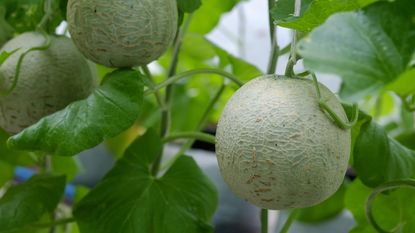

Need advice on what to plant in a greenhouse? If you've recently invested in one of these garden structures, you'll be pleased to know that there are plenty of grow-your-own options. And if you're still weighing up the idea of getting one in the first place, then this list of delicious picks will most likely sway your decision.
You may wish to add more exotic crops – melon, for instance – to your list of greenhouse ideas, which will thrive in the warmer conditions. Tender plants such as chilies and tomatoes are also well-suited choices that are great for even the most novice gardeners. Or, maybe you want to get a head start on sowing hardy veggies for an early harvest. All are possible with the help of a greenhouse.
Get your best harvest yet with these 10 picks for what to plant in a greenhouse
Our suggestions for what to grow in a greenhouse will help you make the very most of your vegetable garden this year.
1. Chilies
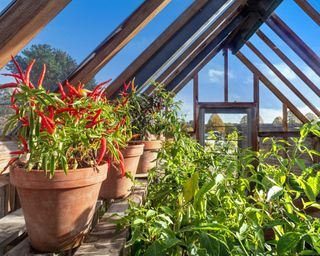
There are lots of different chilies to try
Chilies are a fabulous ingredient in the kitchen, adding a kick to curries, stir-fries, pasta dishes, and everything in-between. And if you're short on space and have opted for one of the best mini greenhouses then they're a brilliant addition.
Learning how to grow chilies is relatively simple. They love bright light, shelter, and warmth, which makes them the perfect match for greenhouses. Start off the seeds in a heated propagator if your greenhouse is unheated, or indoors on a sunny windowsill, covered with a clear plastic bag. Once germinated, remove them from the propagator (or take away the bag). Transplant seedlings into individual pots when leaves appear. The RHS advises to keep them at a temperature of 60–64ºF (16–18ºC) and water regularly.
From the ferociously hot Scotch Bonnet 'Animo Red' to the sweet and mild 'Trinidad Perfume', there are all kinds of varieties to try. And don't forget that as well as using them fresh, you can dry them to add to dishes all year-round.
Best time to plant: Late winter to mid-spring
2. Tomatoes
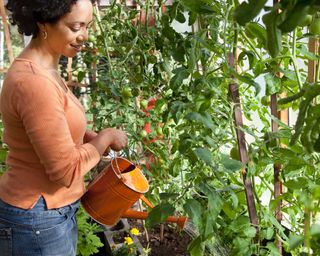
Support cordon tomatoes with stakes
Learning how to grow tomatoes is an easy skill that will reward you with the most delicious summer fruits. As they are tender plants, they do very well in greenhouses, offering a longer growing season than those grown outdoors.
You can choose between bush or cordon varieties. Bush ones don't require staking or pinching out, so are often the best type to start with if you're a beginner. Whichever you choose, providing some sort of shade in the very height of summer can be useful to prevent tough skins.
Put pots of sown seeds on a warm, bright windowsill or in a propagator to encourage them to germinate. When it's time to transplant them into their final positions, gardening expert Monty Don of Gardeners' World advises to plant them deeply – 'at least up to the first leaves.' This will encourage them to grow more roots.
Best time to plant: Late winter to mid-spring
3. Melons
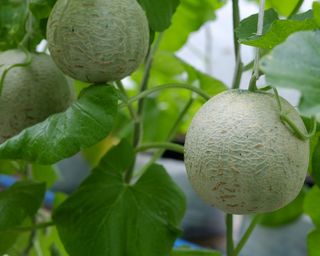
Cantaloupe melons are easier to grow than you might think
A slice of juicy, fragrant melon is a real treat on a summer's day. These crops thrive in heat and humidity. So, if you have a greenhouse, it's not too tricky to grow your own.
They need fertile and moisture-retentive soil. If space is at a premium, consider growing your melons vertically. Keep watering regularly, until the fruit begins to ripen, then reduce. Similar to growing tomatoes, provide shading if it's very sunny.
It's also important to provide ventilation when the plants are in flower – this will allow the crops to be pollinated, as the RHS explains.
Cantaloupe are firm favorites with their sweet, orange flesh. Alternatively, how about learning how to grow watermelon with our guide?
Best time to plant: Early to mid-spring
4. Cucumbers
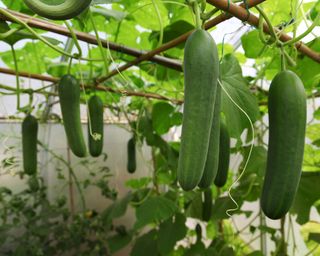
Save on space by training cucumbers to grow up high
Learning how to grow cucumbers is another top choice for what to plant in a greenhouse. These delicious veggies are perfect for summer salads or sandwiches. Plus, homegrown ones taste so much better than ones bought in the shops.
It is important to note that there are two types of cucumbers: ones suitable for growing in greenhouses and ones that are grown outdoors. Greenhouse varieties provide long, smooth cucumbers. If you opt for an 'all female' type, you won't need to pinch out the male flowers (these are the ones that don't have immature fruits growing behind them).
Cucumbers are another crop that can be trained upwards, saving on space. Don't let them get too cold – the RHS recommends keeping the plants above 53–59°F (12–15°C).
Best time to plant: Mid-February to mid-March if you're growing them in a heated greenhouse and April for unheated greenhouses
5. Aubergines
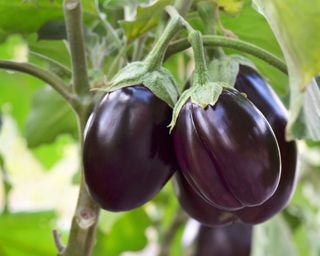
Try growing aubergines in your greenhouse this year
There are lots of decisions to be made when it comes to choosing a greenhouse. If you opt for a heated one, you can start some crops earlier. In the case of aubergines, this can be as early as January.
Transplant plants to their final position in spring. You'll need to provide stakes for most varieties to support the heavy fruits. Mist the leaves and water regularly, and feed periodically with a high potassium fertilizer when fruits begin to appear.
They're a delicious and versatile ingredient and can be the real star of the show in many vegetarian dishes.
Best time to plant: January if growing in a heated greenhouse, otherwise February onwards
6. Potatoes
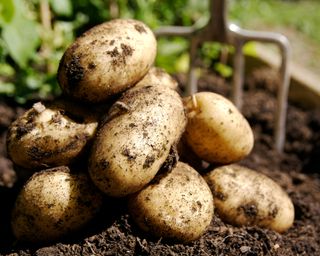
Start potatoes in your greenhouse for an earlier harvest
If you learn how to grow potatoes in your greenhouse during the leaner months, you'll give yourself and your family a supply all year long. Plus, the greenhouse will keep them frost-free.
If your greenhouse is a smaller design, you can grow potatoes in bags, containers, or a barrel. You do need to chit them first – this is when you encourage them to sprout before you plant them in your greenhouse. You can do this in January and February, then plant them in your container about six weeks later when the shoots are about an inch high.
Best time to plant: Early spring
7. Brussels sprouts
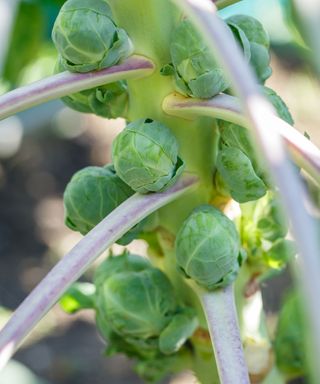
This nutritious vegetable can be started early in a greenhouse
They may have had a bad rep over the years. But with some simple cooking skills, there are ways to transform the humble sprout into a delicious side dish. Plus, Brussels sprouts are a great source of vitamin C and folate, and the 'Brodie' variety has good holding ability and is disease resistant.
Sow seeds in a greenhouse for a head start. You can then plant them outdoors in early summer. There's more advice on how to grow Brussels sprouts in our guide.
Best time to plant: February
8. Peas
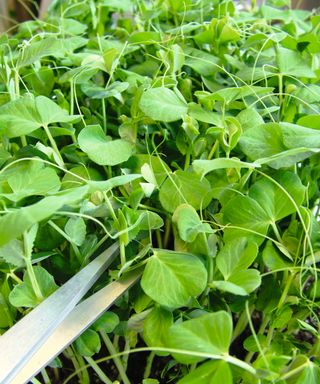
If you sow peas early enough, they will be ready for your plate in early spring. Sow them alongside other hardy plants like leeks and sprouts, so that once the warmer weather appears you can plant them out.
Peas do like a bit of warmth to aid their growth, so investing in a heated propagator could be worth it. This particular variety of pea pictured above can also be used in salads and is highly nutritious and easy to grow. It also provides a second crop a few weeks later.
Best time to plant: February onwards
9. Kale
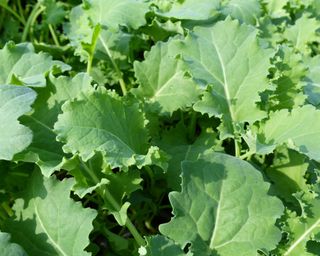
Full of nutritional value and called a 'superfood', this dwarf variety of kale was introduced before 1865 and produces an abundance of tender and delicate densely curled green leaves, of which the younger ones are perfect for salads.
For salads, you can sow it all year round in your greenhouse. But, if you want it to mature then you should transplant seedlings five weeks after sowing into rich firm soil outdoors, with plenty of well-rotted manure dug in.
Best time to plant: Early spring if aiming to plant out
10. Cabbages
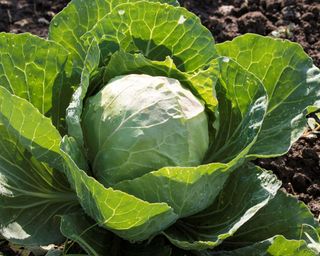
Cabbages are a stalwart of the veg patch and can be sown in your greenhouse to start
If you start your summer cabbages off in late winter, they'll be ready for planting outdoors in the spring. They are a 'cool season' veg, which means they do well in greenhouses when it's colder.
Rich in vitamin C and antioxidants, some varieties are delicious eaten raw as well as cooked. All you need to do is sow some seeds in a tray with compost, water well, and watch them grow until they are ready for transplanting into larger pots.
As the weather gets warmer, get them accustomed to outdoor temperatures by placing them outside during the day, then plant them out around 18in (45cm) apart in raised garden beds.
Best time to plant: Late February to early March
What are some common problems when growing crops in a greenhouse?
Knowing what to plant in a greenhouse is the first step towards a fantastic harvest. However, there are a few common problems to watch out for.
Some plants can be susceptible to powdery mildew and gray mold when growing in a greenhouse. To avoid this, encourage the air to circulate by not crowding plants too close together. Also, be sure to provide plenty of ventilation by opening greenhouse vents on milder days. In winter, 'a combination of high temperatures and low light makes leaves and stems soft, spindly, and prone to gray mold which spreads rapidly in cool, damp conditions,' says the experts at Hartley Botanic, one of the oldest and most respected glasshouse and greenhouse manufacturers in the UK. 'Though good air circulation is vital, avoid chilling draughts – don't leave the door open and always err on the side of caution.'
You should also ensure that your soil has enough drainage. Don't forget about good plant hygiene, too – grab your pair of best secateurs and remove any dead or decaying matter quickly.
Another problematic issue can be pests. These include red spider mites, whitefly, and aphids. Keep an eye out so you can take action quickly should you spot them. Our guide on how to get rid of aphids has lots of useful tricks and tips.
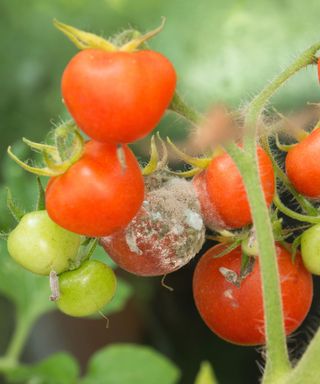
Watch out for gray mold
What flowers can you grow in a greenhouse?
Don't forget that greenhouses can be useful for growing flowers, too, particularly if you want to give them an early start.
As early as January, antirrhinums and lobelia can be sown in a heated propagator at a minimum of 70–75°F (21–24°C), explains Hartley Botanic. You can also sow begonias, which 'should be sown on the surface of moist compost and left uncovered as they need light to germinate.'
Geraniums are another option – when sowing, 'lightly cover geranium seed with fine grade vermiculite,' they advise. Greenhouses are also a good place to overwinter your geranium plants to protect them from frost.
As the team explains in their online magazine, you can also use your greenhouse to plant non-hardy bulbs or corms such as hymenocallis, veltheimia and moisture-loving watsonia during winter.
'Gladiolus, tigridia and the more tender species of agapanthus can be grown on in warmth until early summer, and then planted outdoors a few weeks before they are due to flower,' they add.
The team also suggests growing freesias, which 'can be grown for display or cutting and flower naturally in late winter and thrive in a cool greenhouse. Also, try polyanthus (primula), molucella or 'bells of Ireland' and for later in the year, eustoma (prairie gentian). All these plants are easy to grow and will give impressive results.'
Greenhouses can be used to grow new perennials taken from cuttings, too. You can learn all about how to take cuttings from plants with our guide.
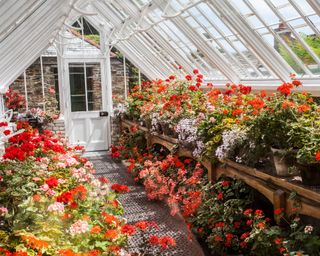
Geraniums can be brought into a greenhouse over winter

The garden was always a big part of Holly's life growing up, as was the surrounding New Forest where she lived. Her appreciation for the great outdoors has only grown since then. She's been an allotment keeper, a professional gardener, and a botanical illustrator – plants are her passion.
-
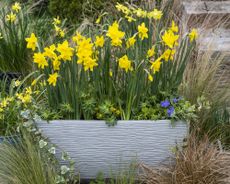 An Update on Gardeningetc
An Update on GardeningetcA word from our publisher
By Beth Murton Published
-
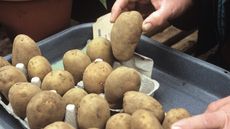 Do you need to chit potatoes? Find out what the experts say
Do you need to chit potatoes? Find out what the experts sayGrow Your Own Learn how to chit potatoes before planting them in the ground and you’ll be on your way to getting an earlier and bigger harvest
By Drew Swainston Published
